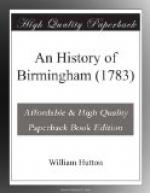If the traveller is tired with this tedious journey, and dull description, which admits of no variety, we will stop for a moment, and refresh in this Roman city.
In drawing the flewks of his oar along the bed of the river, as he boats over it, he may feel the foundations of a Roman bridge, nearly level with its bottom. Joining the water are the vestiges of a castle, now an orchard. Roman coins are frequently discovered—In 1765, I was presented with one of Vespasian’s, found the year before in scowering a ditch; but I am sorry to observe, it has suffered more during the fifteen years in my possession, than during the fifteen hundred it lay in the earth.
The inhabitants being in want of materials to form a turnpike road, attempted to pull up this renowned military way, for the sake of those materials, but found them too strongly cemented to admit of an easy separation, and therefore desisted when they had taken up a few loads.
I saw the section of this road cut up from the bottom: the Romans seem to have formed it with infinite labour and expence. They took out the soil for about twenty yards wide, and one deep, perhaps, till they came to a firm bottom; and filled up the whole with stones of all sizes, brought from Duffield, four miles up the river; cemented with coarse mortar.
The road here is only discoverable by its barren track, along the cultivated meadows. It then proceeds over Morley-moor, through Scarsdale, by Chesterfield, Balsover, through Yorkshire, Northumberland, and terminates upon the banks of the Tine, near Tinmouth.
There are many roads in England formed by the Romans: they were of two kinds, the military, which crossed the island; and the smaller, which extended from one town to another. The four I have mentioned come under the first class: they rather avoided, than led through a town, that they might not be injured by traffic.
Two of these four, the Watling-street, and the Ikenield-street, are thought, by their names, to be British, and with some reason; neither of the words are derived from the Latin: but whatever were their origin, they are certainly of Roman construction.




